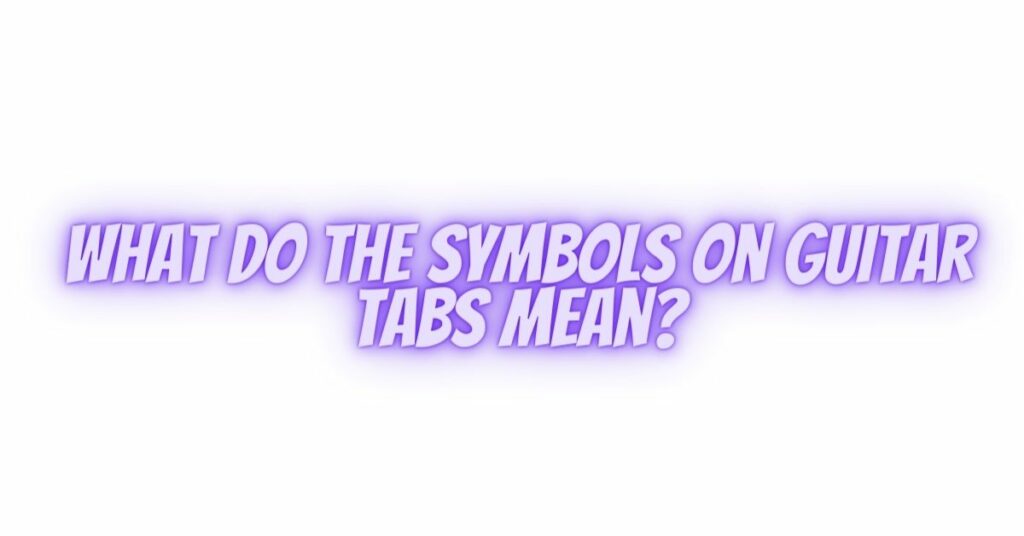Guitar tablature, often referred to as “tabs,” is a popular and accessible way for guitarists to notate and share music. Tabs provide a visual representation of guitar fingerings and note placements on the fretboard. To read tabs effectively, it’s essential to understand the symbols and notations used. In this comprehensive guide, we’ll delve into the world of guitar tablature symbols, explaining what they mean and how to interpret them.
1. The Basic Tab Structure:
Before we dive into the symbols, let’s establish the fundamental structure of a guitar tab:
- Strings: The horizontal lines in a tab represent the strings of the guitar, with the top line being the highest-pitched string (usually the high E string) and the bottom line the lowest-pitched string (usually the low E string).
- Numbers: Numbers on the lines indicate which fret to press on that string. For example, “2” on the high E string means to press the second fret on that string.
2. Symbols and Notations:
Now, let’s explore the common symbols and notations you’ll encounter in guitar tabs:
a. Hammer-Ons and Pull-Offs:
- H: A “H” between two notes indicates a hammer-on. It means you should play the first note and then, without picking again, use another finger to sound the second note by tapping the string.
- P: A “P” between two notes represents a pull-off. It instructs you to play the first note, and then, without picking again, remove your finger to sound the second note.
b. Slides and Bends:
- / or : A forward slash “/” or a backslash “” between two notes signifies a slide. ” /” indicates a slide upwards, while “” indicates a slide downwards. The number of frets to slide is often specified.
- B: A “B” followed by a number indicates a bend. It instructs you to bend the string at a specific fret to raise the pitch of the note.
- ^: A caret symbol “^” represents a bend. The number above it indicates the number of half steps (semitones) to bend the string.
c. Vibrato and Trills:
- ~: A tilde symbol “~” signifies vibrato. It instructs you to oscillate the pitch of the note by slightly bending the string back and forth.
- Tr: “Tr” indicates a trill. It’s a rapid alternation between two adjacent notes, often involving hammer-ons and pull-offs.
d. Harmonics and Artificial Harmonics:
- Harm: “Harm” stands for harmonics. It indicates that you should produce a harmonic note by lightly touching the string at specific points and then picking it.
- AH: “AH” signifies artificial harmonics. It instructs you to create harmonics using a specific technique, often involving the thumb.
e. Tapping:
- T: A “T” indicates tapping. It’s a technique where you tap the string with your picking hand’s finger instead of picking with your strumming hand.
f. Palm Muting:
- P.M.: “P.M.” stands for palm muting. It instructs you to rest the palm of your picking hand lightly on the strings near the bridge to dampen the sound.
g. Repeat Symbols:
- |: and :|: These symbols indicate the beginning and end of a repeated section. When you encounter “|:”, you should repeat the section until you reach “:|.”
h. Time Signatures and Rhythm Notations:
- Standard musical notation is often used in conjunction with tabs to indicate rhythm, including time signatures, note durations, and rests.
3. Song Structures:
In addition to symbols, tabs often include annotations like “Intro,” “Verse,” “Chorus,” and “Bridge” to help you navigate the song’s structure.
4. Special Techniques:
Some songs may feature specific techniques unique to the song, and these are usually explained in the tab or provided as notes.
Conclusion
Guitar tabs are a fantastic tool for guitarists to learn and play songs. By understanding the symbols and notations used in tabs, you can effectively translate the visual representation into beautiful music. Practice, patience, and familiarity with these symbols will help you become a proficient tab reader and a skilled guitarist. Keep exploring tabs and enjoy playing your favorite songs on the guitar!

